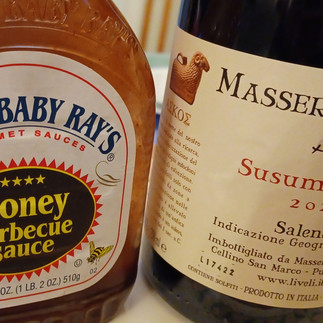A Susumaniello from Puglia with Smoked Ribs
- Culinary Cam

- Jan 25, 2023
- 3 min read
In preparation for February's #ItalianFoodWineTravel event, I opened a few bottles of wine from Puglia, including a completely new-to-me variety called Susumaniello. I brought it to a dinner when friends invited us over for smoked ribs.

Susumaniello? What is that?! Still in the first month of 2023, I have already poured several new-to-me grapes and all of them have been Italian. You can read about my recent experiences with Perricone, with Carricante, and with Catarratto. Susumaniello is number four.
Susumaniello is a little-known red wine grape from Puglia or Apulia as the Italians call the region. Grown almost exclusively in the Salice Salento area, and a select number of vineyards around Brindisi, it is enjoying a renaissance of sorts albeit a small surge. There are many theories of its origins with the most popular being that it came to Apulia across the Adriatic Sea from either Greece or Croatia. A dive into its DNA shows it's a natural hybrid of a red Puglian grape and the white wine grape called Garganega.
Its name is also interesting, Susumaniello is also called Somarello which means 'little donkey,' because the vines were so high-yielding that small donkeys were required to haul the harvests.
Used to make both red and rosé wines, Susumaniello is usually blended with Negroamaro. I was excited to get my hands on a bottle of the 2021 Li Veli Askos Susumaniello. I have poured one of their wines before, a 2018 Li Veli Orion Primitivo and thoroughly enjoyed it.
Masseria Li Veli is located on an ancient Messapian site on the Salento Plain. The Messapians were one of three tribes who inhabited Salento between the beginning of the first millennium BC and the first century BC. 'Masseria' is a term used in the Puglia region and refers to a farmhouse of country house on a larger estate.
The Li Veli estate produces wine from mostly native grape varieties and is comprised of over 80 acres of vineyards. While the main focus is on Negroamaro and Primitivo grapes, they do have lesser-known varieties such as Susumaniello, Verdeca, and Minutolo. Now I am definitely on the hunt for those latter two.
I loved learning that they utilize an ancient form of vinetraining where albarello ('little trees') vines are configured in a hexagonal formation that allows for high-planting density, offers maximum exposure to the sun, and facilitates air circulation. The albarello method of pruning, popular in Southern Italy, helps the vines conserve water because it keeps the vines closer to the ground. Additionally, all of the grapes at the Li Veli estate are grown using sustainable methods. And all are harvested by hand.
This wine poured a brilliant, deep ruby red. On the nose aromas of black and red fruit abounded with the addition of the herbaceousness of fennel and menthol hints of eucalyptus. On the palate, this was full-bodied but still lithe and balanced.
Smoked Ribs
Since I didn't make these, and I don't have a smoker, I won't post the recipe. I might be able to wrangle something out of Mike eventually, but he cooks by feel and changes up his recipe to match whatever he feel like doing.

When they were ready, Mike had me taste the three versions of the smoked ribs. I thought that the wine paired the best with his Sweet Baby Ray's Honey Barbeque Sauce ribs. Here's my tried-and-true oven-roasted ribs process.
I can't wait to read more about the pairings from the #ItalianFWT group as we explore the wines of Puglia. Stay tuned!














Comments